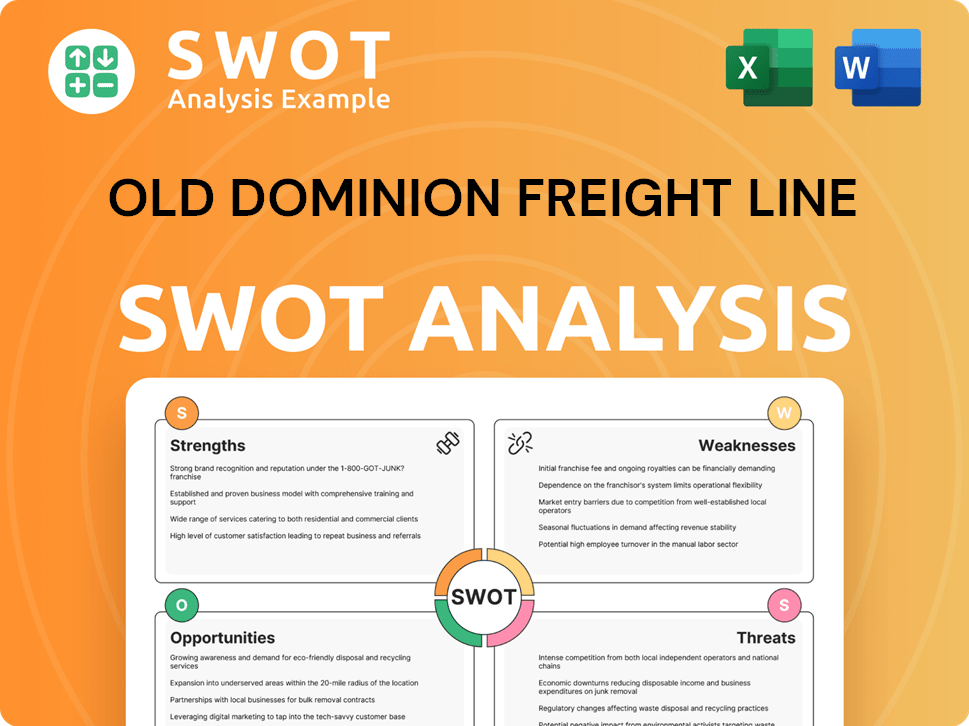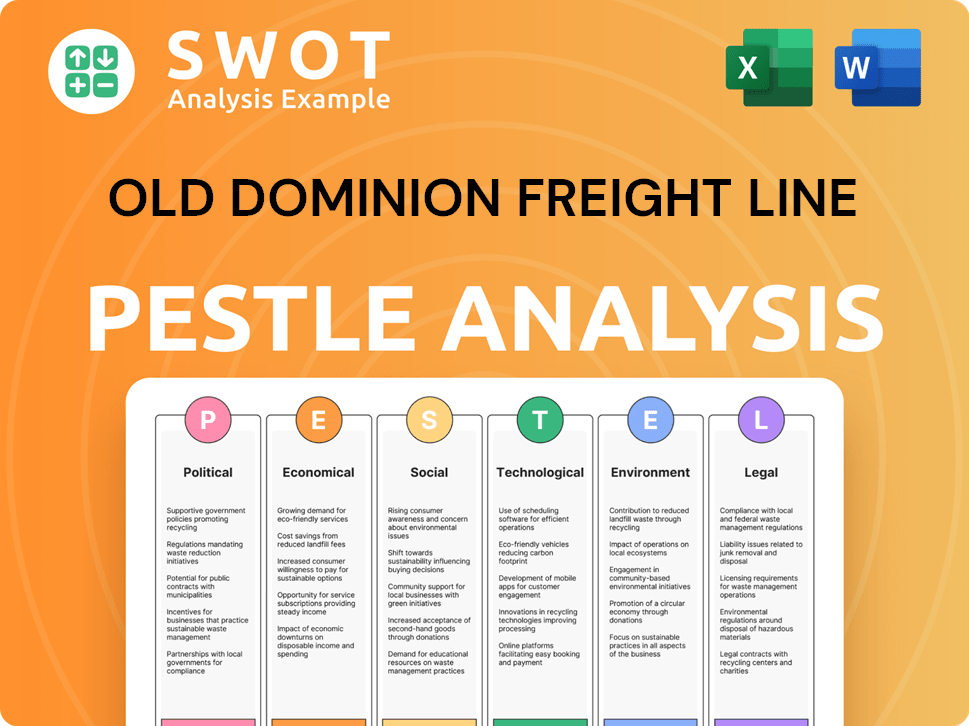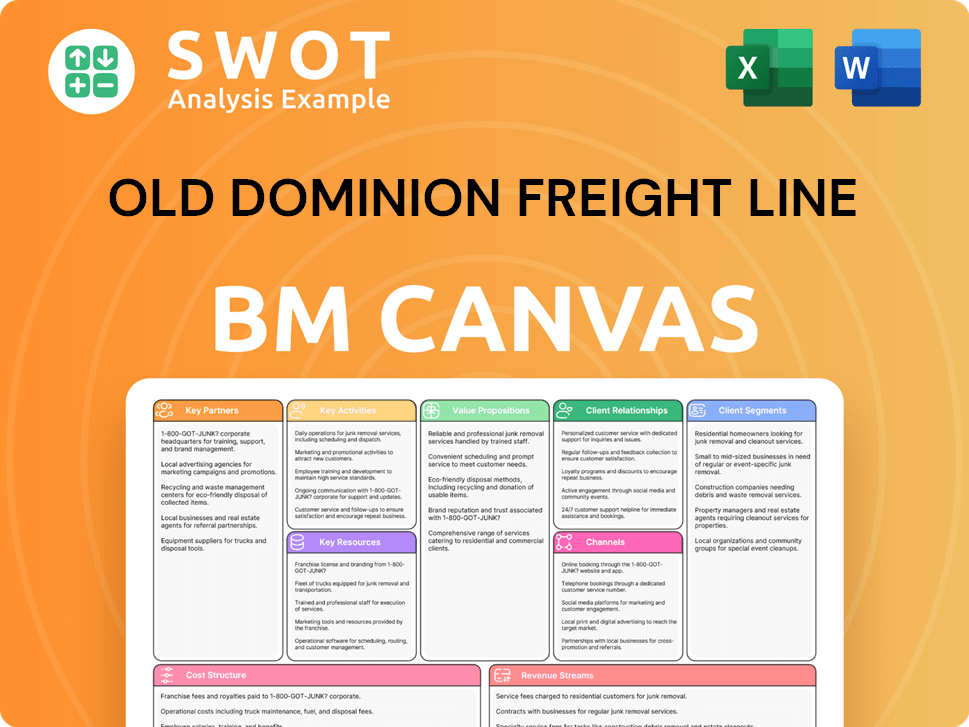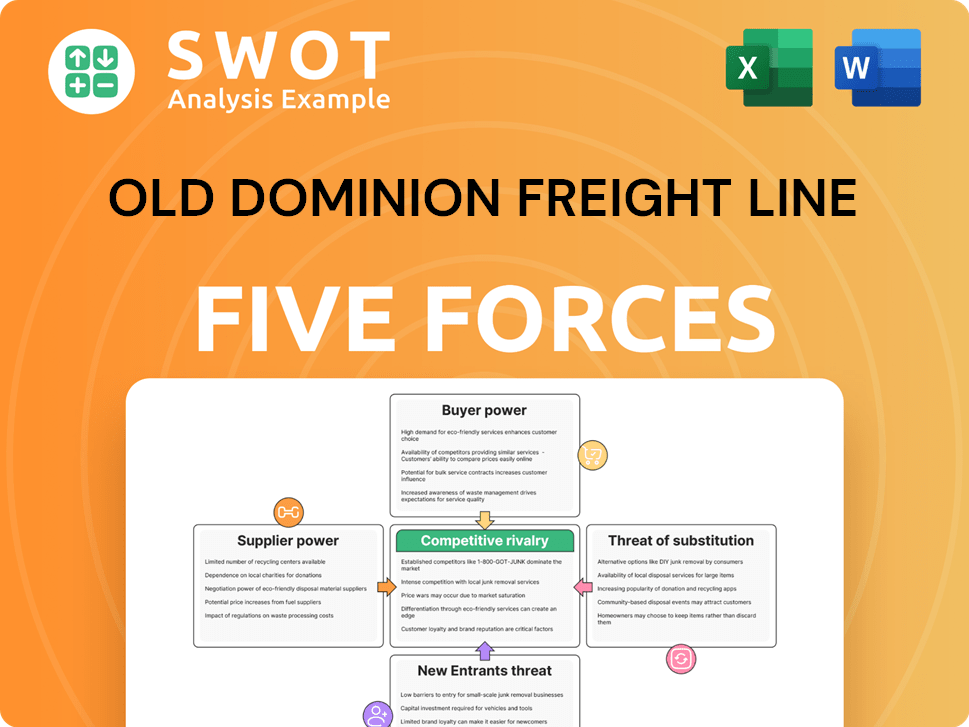Old Dominion Freight Line Bundle
Can Old Dominion Freight Line Conquer the Shifting Shipping Industry?
The freight transportation sector in 2025 is a battlefield of economic pressures and evolving strategies, and at the heart of it all is Old Dominion Freight Line (ODFL). From its humble beginnings in 1934, ODFL has transformed into a major player, but how does it stack up against the competition? This analysis dives deep into the Old Dominion Freight Line SWOT Analysis, exploring its position in the competitive landscape.

This exploration will dissect the Old Dominion Freight Line SWOT Analysis, examining its market share, and financial performance. We'll identify ODFL competitors, analyze its competitive advantages, and evaluate the freight transportation industry analysis to understand its growth strategy. Understanding these elements is crucial for anyone looking to navigate the complexities of the shipping industry and make informed decisions about the best freight companies in the US.
Where Does Old Dominion Freight Line’ Stand in the Current Market?
Old Dominion Freight Line (ODFL) holds a significant position in the freight transportation industry. It operates primarily within the less-than-truckload (LTL) sector. The company is known for its extensive network and comprehensive service offerings, catering to various sectors.
The company's core operations revolve around providing regional, inter-regional, and national LTL services, all managed through a unified, non-union network. This integrated approach enables efficiency and reliability in freight transportation. Beyond its core LTL services, ODFL offers value-added services, including expedited transportation, supply chain consulting, and truckload brokerage, enhancing its appeal to a diverse customer base.
The value proposition of Old Dominion Freight Line lies in its commitment to providing industry-leading service quality and network density. This strategy has allowed it to maintain a strong market share and position itself for growth. The company's focus on financial prudence and operational excellence has solidified its reputation within the shipping industry.
Old Dominion Freight Line ranks as the second-largest LTL carrier in the United States. Its market capitalization stood at $33.8 billion as of June 2, 2025. The company's revenue in Q1 2025 was $1.37 billion.
In the first quarter of 2025, ODFL's revenue decreased by 5.8% compared to the same period in 2024. Despite this, the company maintained its market share, which remained between 12.5% and 13% in Q1 2025. The company’s financial health is robust, with total debt of only $59.99 million as of December 31, 2024.
Old Dominion offers regional, inter-regional, and national LTL services. They also provide value-added services like ground and air expedited transportation. The company serves the manufacturing, retail, and government sectors.
ODFL focuses on maintaining industry-leading service and boosting network density. This strategy helps sustain market share and prepares the company for growth. Analysts at Zacks.com believe ODFL is well-positioned to handle industry challenges.
Old Dominion Freight Line's strengths include a strong market position, a robust financial foundation, and a focus on service quality. These factors contribute to its ability to navigate challenges within the competitive landscape of the freight transportation industry.
- Maintains a strong market share through strategic focus.
- Offers a comprehensive suite of services, including LTL and value-added options.
- Demonstrates financial prudence with a low debt profile.
- Has a history of superior profitability and capital returns.
- Brief History of Old Dominion Freight Line reveals the company's evolution and strategic decisions.
Old Dominion Freight Line SWOT Analysis
- Complete SWOT Breakdown
- Fully Customizable
- Editable in Excel & Word
- Professional Formatting
- Investor-Ready Format

Who Are the Main Competitors Challenging Old Dominion Freight Line?
The competitive landscape for Old Dominion Freight Line (ODFL) in the freight transportation sector is dynamic, with several key players vying for market share. Understanding the ODFL competitors and the broader shipping industry is crucial for evaluating its position. A thorough market analysis reveals the strategies and challenges faced by ODFL and its rivals.
Old Dominion Freight Line operates in the less-than-truckload (LTL) market, where it faces both direct and indirect competitors. These rivals employ various strategies, from expanding capacity to competing on pricing and service offerings. The freight transportation industry analysis highlights the evolving dynamics and the impact of mergers, acquisitions, and emerging players.
The company's financial performance and growth strategy are constantly under scrutiny, especially when compared to its competitors. The following section examines the key players and their impact on the competitive environment.
Direct rivals include FedEx Freight, Estes Express Lines, Saia, and XPO Logistics. These companies compete directly with Old Dominion in the LTL market. The competitive landscape is shaped by their strategies and market positions.
FedEx Freight is currently the largest LTL carrier in the United States. The uncoupling of FedEx is scheduled for 2026, which is expected to create the largest LTL and trucking operation in the U.S. This strategic move will likely intensify competition.
Saia has been aggressively expanding its network, including absorbing parts of Yellow's former network. In 2024, Saia opened 21 new terminals and relocated 9 others. This expansion led to a 12.2% year-over-year increase in tonnage in February 2025.
XPO Logistics is another significant competitor in the LTL market. The company's strategies and market positioning directly challenge Old Dominion Freight Line.
Other notable competitors include J.B. Hunt Transport Services, ArcBest, and UPS Freight. These companies also compete with Old Dominion Freight Line in the freight transportation industry.
The LTL market is seeing emerging players and shifts in competitive dynamics. Amazon has expanded its LTL services, primarily for its own suppliers. This expansion represents a potential watch point.
These competitors challenge Old Dominion through various strategies, including capacity expansion, pricing, and service offerings. The strategic absorption of Yellow's former network by companies like Saia is reshaping the competitive landscape. The freight transportation industry analysis reveals the impact of these moves on market dynamics. The competitive pressure is evident in ODFL's recent financial results.
Old Dominion Freight Line's Q1 2025 financial results showed a revenue decrease of 5.84% year-over-year. This decline was faster than the 4.33% decrease experienced by its competitors in the same quarter. The financial performance highlights the intense competitive environment.
- The decrease in revenue indicates the challenges ODFL faces in maintaining its market share.
- The faster decline compared to competitors suggests increased competitive pressure.
- The company's growth strategy must address these challenges to remain competitive.
- Understanding the competitive landscape is crucial for investors and stakeholders.
Old Dominion Freight Line PESTLE Analysis
- Covers All 6 PESTLE Categories
- No Research Needed – Save Hours of Work
- Built by Experts, Trusted by Consultants
- Instant Download, Ready to Use
- 100% Editable, Fully Customizable

What Gives Old Dominion Freight Line a Competitive Edge Over Its Rivals?
In the dynamic freight transportation sector, understanding the competitive landscape is crucial. Old Dominion Freight Line (ODFL) distinguishes itself through a combination of operational excellence, customer-centric service, and robust financial health. This strategic focus has allowed ODFL to maintain a strong position within the shipping industry.
The company’s consistent performance, including a 99% on-time service record and a cargo claims ratio below 0.1%, sets a high standard. These metrics, coupled with strategic investments in infrastructure and employee training, have built a highly profitable network. For a deeper dive into their strategic approach, consider reading about the Growth Strategy of Old Dominion Freight Line.
Market analysis reveals that ODFL's disciplined approach to yield management and economies of scale are key differentiators. The company's ability to navigate market fluctuations and maintain profitability underscores its resilience. This ability to effectively pass through costs to customers is a significant advantage, especially in a competitive market.
ODFL's operational efficiency is a cornerstone of its success. This includes a vast network of over 250 service centers and more than 11,000 tractors, enabling greater network density and efficient operations. This extensive infrastructure allows for efficient operations and contributes to superior service quality.
The company consistently achieves a 99% on-time service performance and maintains a cargo claims ratio below 0.1%, setting it apart from competitors and fostering strong customer loyalty. This commitment to excellence is a direct result of strategic investments in its service centers, fleet, and employee training.
ODFL's financial flexibility, characterized by a virtually debt-free balance sheet and strong cash flow generation—with $1.66 billion in net cash from operating activities in fiscal year 2024—provides a substantial buffer during economic uncertainties. This financial stability allows for strategic investments and resilience.
Despite a 6.3% decrease in LTL tons per day in Q1 2025, the company managed to increase its LTL revenue per hundredweight by 2.2%, or 4.1% excluding fuel surcharges, demonstrating its pricing power even in a softening market. This ability to effectively manage pricing is a significant advantage.
ODFL's competitive advantages stem from operational efficiency, superior service quality, and robust financial health. These factors have helped the company maintain its position in the freight transportation industry analysis. Despite facing challenges like market softening, ODFL's strategic initiatives have allowed it to maintain its competitive edge.
- Economies of Scale: The company benefits from an expansive network of over 250 service centers and more than 11,000 tractors.
- Yield Management: ODFL's ability to increase LTL revenue per hundredweight, even in a softening market, demonstrates strong pricing power.
- Financial Flexibility: A virtually debt-free balance sheet and strong cash flow generation provide a substantial buffer during economic uncertainties.
- Customer Loyalty: High on-time service performance and low cargo claims contribute to strong customer relationships.
Old Dominion Freight Line Business Model Canvas
- Complete 9-Block Business Model Canvas
- Effortlessly Communicate Your Business Strategy
- Investor-Ready BMC Format
- 100% Editable and Customizable
- Clear and Structured Layout

What Industry Trends Are Reshaping Old Dominion Freight Line’s Competitive Landscape?
The shipping industry is experiencing dynamic changes, with companies like Old Dominion Freight Line (ODFL) navigating a complex competitive landscape. The freight transportation sector is influenced by technological advancements, shifting consumer demands, and economic fluctuations, influencing Old Dominion Freight Line's market share and strategic decisions. Understanding the current market dynamics and future outlook is crucial for evaluating ODFL's position.
The freight transportation industry analysis reveals both challenges and opportunities for ODFL. The company faces headwinds such as potential freight demand softness and increased competition. However, strategic investments and a focus on service quality position ODFL to capitalize on e-commerce growth and emerging market opportunities. For more information, you can check out the article about Owners & Shareholders of Old Dominion Freight Line.
The LTL market was valued at $227 billion in 2024 and is projected to grow at a CAGR of 5.3% between 2025 and 2034. AI and automation are key technological drivers, optimizing routes and enhancing asset utilization. E-commerce fuels demand for faster, more flexible delivery solutions, including same-day and next-day options.
Ongoing softness in freight demand and potential for a prolonged freight recession pose significant challenges. In Q1 2025, ODFL's total revenue decreased by 5.8% year-over-year to $1.37 billion. Competitive pressures and regulatory changes, such as LTL freight classification changes, will require adaptation.
Growth opportunities exist in emerging markets and through continued product innovations. ODFL is targeting an improvement in its operating ratio by approximately 100 basis points in Q2 2025 and aiming for a long-term sub-70 operating ratio. Strategic investments in network and service capabilities will support long-term growth.
In Q1 2025, ODFL's operating ratio worsened to 75.4% from 73.5% in Q1 2024, indicating margin pressure. The company plans a capital expenditure of approximately $450 million for 2025, focusing on real estate, service center expansion, and IT investments. ODFL's strong financial health supports resilience.
ODFL's strategic focus on technology, infrastructure, and service quality positions it well for the future. Navigating the competitive landscape requires adapting to market dynamics and managing financial performance. Understanding the freight transportation industry analysis is key to making informed investment decisions.
- Investments in AI and automation are crucial for operational efficiency.
- Focus on customer service and flexible delivery options to meet e-commerce demands.
- Strategic capital allocation and disciplined financial management are vital for resilience.
- Monitoring ODFL competitors and adapting to regulatory changes are essential.
Old Dominion Freight Line Porter's Five Forces Analysis
- Covers All 5 Competitive Forces in Detail
- Structured for Consultants, Students, and Founders
- 100% Editable in Microsoft Word & Excel
- Instant Digital Download – Use Immediately
- Compatible with Mac & PC – Fully Unlocked

Related Blogs
- What are Mission Vision & Core Values of Old Dominion Freight Line Company?
- What is Growth Strategy and Future Prospects of Old Dominion Freight Line Company?
- How Does Old Dominion Freight Line Company Work?
- What is Sales and Marketing Strategy of Old Dominion Freight Line Company?
- What is Brief History of Old Dominion Freight Line Company?
- Who Owns Old Dominion Freight Line Company?
- What is Customer Demographics and Target Market of Old Dominion Freight Line Company?
Disclaimer
All information, articles, and product details provided on this website are for general informational and educational purposes only. We do not claim any ownership over, nor do we intend to infringe upon, any trademarks, copyrights, logos, brand names, or other intellectual property mentioned or depicted on this site. Such intellectual property remains the property of its respective owners, and any references here are made solely for identification or informational purposes, without implying any affiliation, endorsement, or partnership.
We make no representations or warranties, express or implied, regarding the accuracy, completeness, or suitability of any content or products presented. Nothing on this website should be construed as legal, tax, investment, financial, medical, or other professional advice. In addition, no part of this site—including articles or product references—constitutes a solicitation, recommendation, endorsement, advertisement, or offer to buy or sell any securities, franchises, or other financial instruments, particularly in jurisdictions where such activity would be unlawful.
All content is of a general nature and may not address the specific circumstances of any individual or entity. It is not a substitute for professional advice or services. Any actions you take based on the information provided here are strictly at your own risk. You accept full responsibility for any decisions or outcomes arising from your use of this website and agree to release us from any liability in connection with your use of, or reliance upon, the content or products found herein.